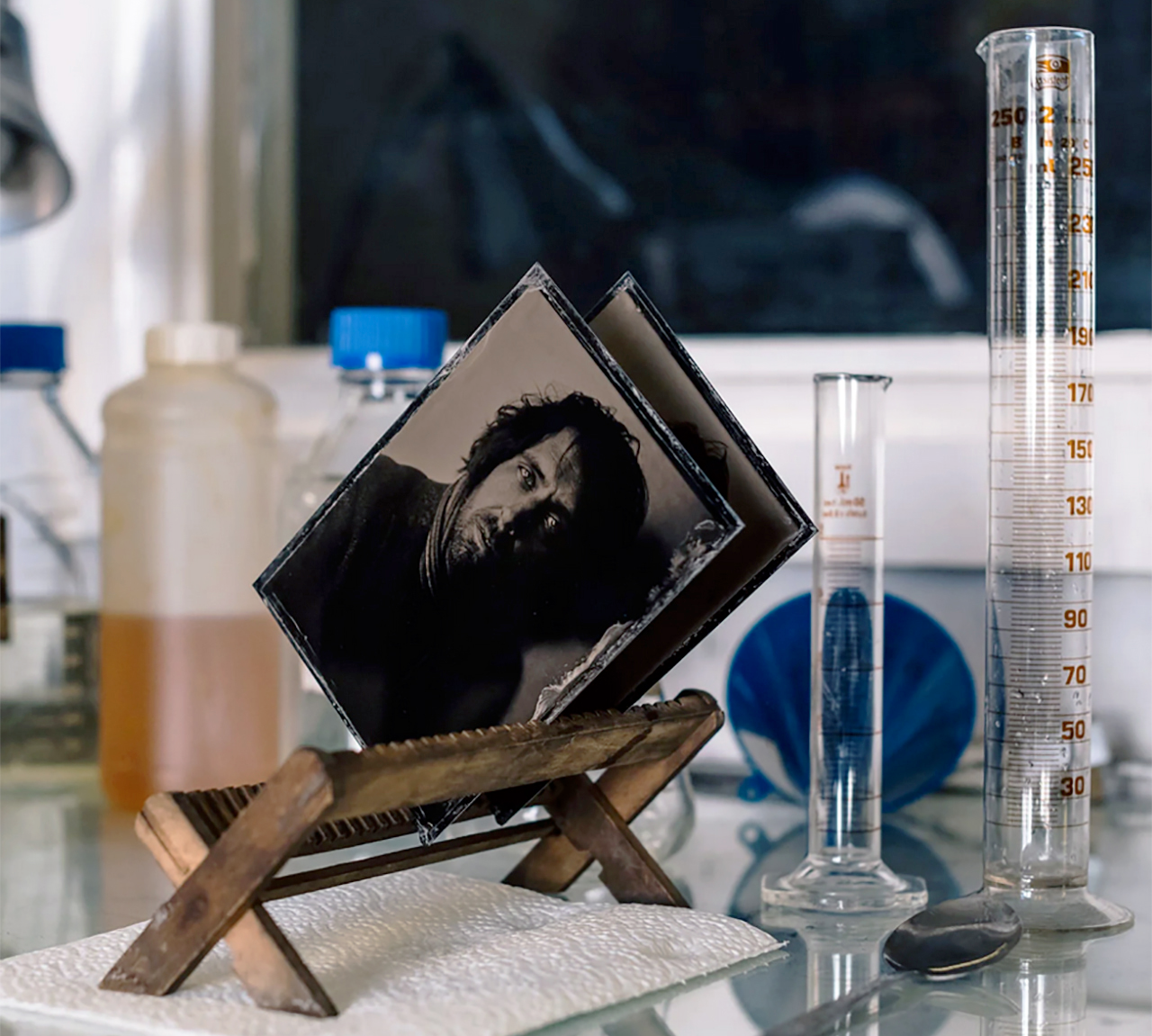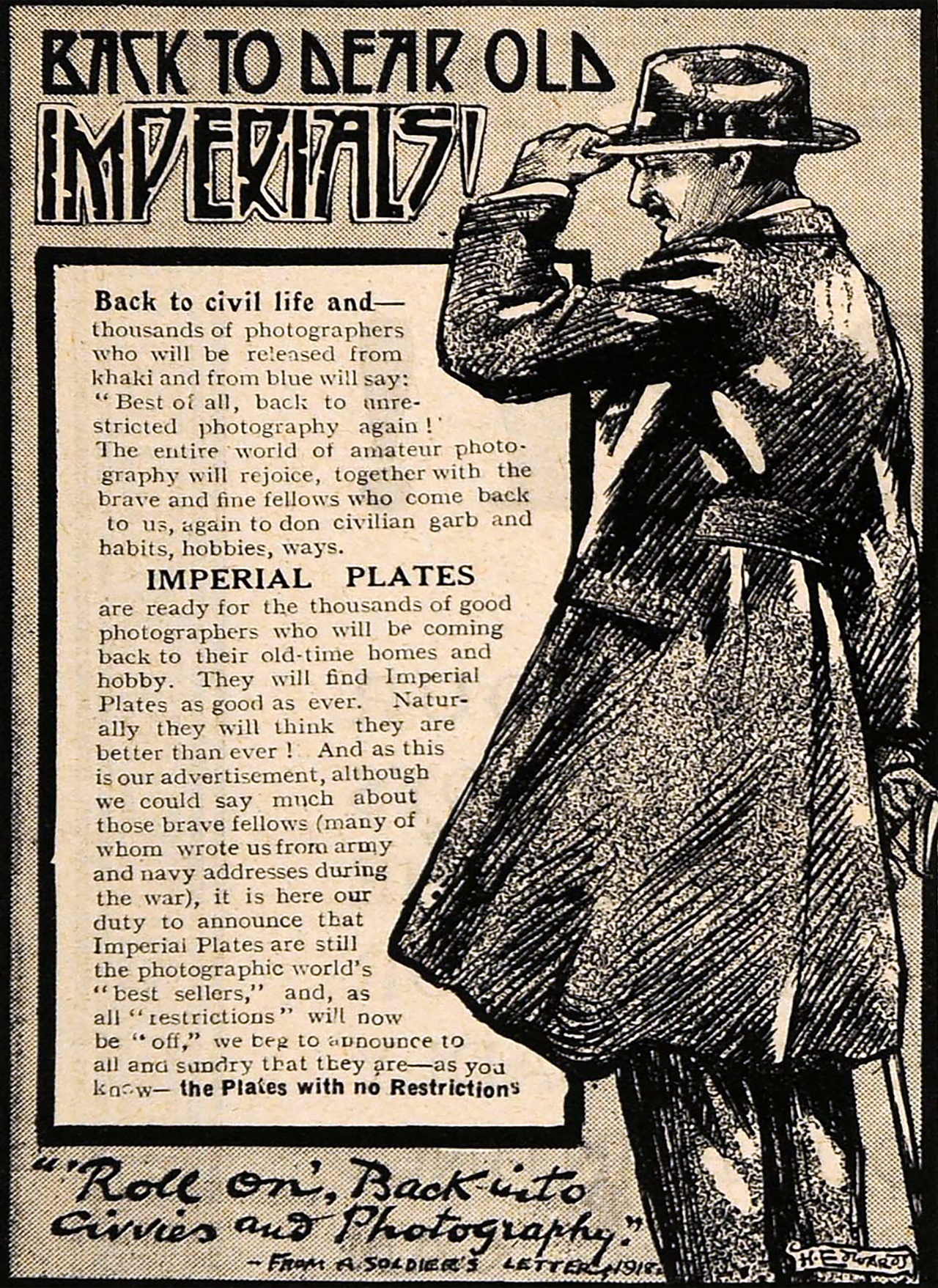of Photographic Equipment
In the early years of photography, the industrial part was mainly limited to assembling a stone or wooden Camera Obscura. A lot of mass production was not involved and the clientele was also very limited.
A number of painters or draftsmen who saw the convenience of the device and a single scientist who was interested in the phenomenon of inversed projection, those were the only users. This changed with the introduction of several processes which were able to produce an image on a surface covered with light-sensitive emulsion.

Daguerre’s silvered metal plate, which created a unique photographic image, was swiftly challenged by the negative-positive processes on paper, developed and championed by William Henry Fox Talbot and others.
The many different processes that were introduced during photography’s first half-century possessed both technical and artistic merits and disadvantages, and each contributed to the remarkable variety of nineteenth-century photography.
The chemicals used in development, such as mercury, silver nitrate, lye, etc. were very dangerous, and often photographers would become victims of chemical poisoning which would cause them to take a sabbatical. Over a long period of time, metals could build up in the photographer’s system and lead to madness or even death.
Frederick Scott Archer’s wet collodion process (also Wet Plate Process) announced in 1851, became the standard photographic negative process for both amateurs and professionals from the mid-1850s until the early 1880s.
Frederick Scott Archer created Wet Plate Negatives by covering glass with collodion solution and silver salts, which were sensitive to light. Because he used glass it was a lot more effective than using paper because it created a lot more detailed image on glass.
To prepare the negative for exposure, a sheet of glass was coated with a solution of iodised collodion and then made light-sensitive by immersion in a bath of silver nitrate. The wet emulsion plate process was a revolutionary discovery. However, the process was still not ideal because the plates had to be sensitised, exposed while still wet and processed immediately after. It required considerable manipulative skill, but produced a negative of unsurpassed sharpness and a broad tonal range.
After Frederick Scott Archer had created this technique photography became more popular, however the glass plates would not be available to everyone and so many people would have to carry around darkrooms. No, when it was possible to put light-sensitive plates in stock and keep it good for a while, only then did it become interesting for entrepreneurs to meet this need.
The wet collodion process had offered many advantages over the daguerreotype and calotype processes in terms of sensitivity, reliability and the quality of the image it produced.
The need to expose and process plates while moist before they lost their sensitivity continued to be a serious disadvantage, although many photographers overcame this obstacle to photograph in difficult climates away from a permanent dark room. There had been attempts to produce dry plates equal in sensitivity to wet plates which could be processed sometime after exposure.
That took place with the introduction of the dry plate or better the gelatine process. This was introduced in 1871 by the English photographer and scientist Richard Leach Maddox. This technique changed photography radically.
The benefits of the dry plate were obvious: photographers could use ready-made dry plates from the store instead of having to prepare their own emulsions in a (mobile) dark room. Moreover, negatives did not have to be developed immediately.
This presented an unparalleled opportunity for camera manufacturers to develop new forms of cameras, which they were quick to do. Smaller and more portable designs of camera were introduced as a direct consequence of the change to plates.
Celluloid film in flat sheets and later roll film also made possible new designs of camera that a waiting market, increasingly dominated by the ‘snapshot’ photography, was keen to buy. For both sensitised goods and camera manufacture the introduction of standardisation to the manufacturing process and techniques of mass-production ensured that prices fell over the period and this supported new markets for photography.
Of course, the number of customers grew also in the other processes from that time like Daguerreotype and Calotype from Fox-Talbot, but these sales areas of these techniques remained relatively small.
Since photography was then still a labour-intensive and fairly expensive affair, the number of potential customers of dry plates was still quite limited. A number of companies from that time that brought dry plates to the market were:
- Stanley Dry Plate Company, Dry Plates and Carte de Visite, Lewiston USA;
- Imperial Dry Plate Co. Ltd., Cricklewood London;
- Ludwig F. Hammer and Hammer Dry Plate Company, St. Louis, USA; and Last-but-Not-Least
- the Seed Dry Plate Company founded in 1883 and purchased in 1902 by the Eastman Dry Plate Company from Rochester, the later Eastman Kodak.
Between the 1840s and 1890s there was a general move by photographers from preparing their own sensitised materials to buying them already prepared as a consequence of changes in photographic chemistry and their commercialisation.
In the case of papers for printing photographs this move was gradual, but the shifts from daguerreotype to wet collodion and from wet collodion to dry plates were much more rapid. By the 1890s the preparation of films and plates and papers had become too complex, the quality of manufactured products was generally assured and there was little financial incentive for a photographer, commercial or amateur, to do so.
On the right: an original 1918 black and white print ad for Imperial Plates for amateur photographers returning to civilian life after World War I, from The Imperial Dry Plate Company, Ltd., Cricklewood, London.

At the end of the 20th century a new technique was signed: photographing with a film roll in the camera. Namely, in 1884 George Eastman, despairing of the intense price competition in the dry-plate market, sought with William H. Walker, a Rochester camera maker, to develop an alternative to common dry plates. He developed a gelatin emulsion that was applied to paper, then removed and varnished with collodion after exposure. This film, which was carried in rolls, was easier to transport than plates and allowed for multiple exposures without fully reloading a camera. He added to the company’s established production of photosensitive materials by designing a simple-to-operate, highly portable roll-film camera, the Kodak.
And Eastman wasn’t just selling the camera. He was selling a service as well. The $25 camera came loaded with a roll of one hundred frames of unexposed film. Taking the photograph was as easy as pushing a button and turning the key for the next frame. When all one hundred frames had been exposed, the photographer sent the camera back to Rochester when Eastman Kodak Company unloaded it, developed pictures, reloaded the camera and sent the pictures and the camera back to the customer. Price for this service: $10.
Eastman created a unique customer experience and associated it with a brand name called “Kodak”. In fact, Kodak later launched a brand campaign: “You press the button, we do the rest”. Not every problem needs a technical solution; something Thomas Alva Edison never understood.
During the next decade the company introduced numerous improvements, including a Celluloid base for film and daylight-loading film cartridges. The company’s tight patent control on the film system and its policy of continuous innovation helped it establish and maintain market dominance.
The photographic industry soon understood that the production and selling of cameras provided a profitable market. But, selling the films belonging to the cameras and the photo prints offered a much more lucrative market.
One company implemented the above-mentioned marketing concept to perfection: the Polaroid company. They brought their own system to the market whereby the cameras were marketed for little money, while the corresponding film was screamingly expensive. Due to the fact that they had the patent in their possession for this system, potential competitors had no chance to grab a part of this market too, as Kodak experienced later painfully.
After Land’s patent was brought to market, many imitators surfaced, some using Polaroid-compatible film and equipment, such as cameras by Keystone, Konica, and Minolta. Others were incompatible with Polaroid cameras and film, the most notable of these being made by Kodak, such as the Kodamatic. These cameras accepted a Kodak-branded integral instant film, similar to Polaroid’s SX-70 film. Polaroid brought a patent-infringement lawsuit against Kodak, and eventually Kodak was forced to stop manufacture of both the camera and film. Kodak was also left to pay a settlement to some customers who were left without a way to use their now-defunct cameras.
Customers were offered the chance to exchange such Kodak cameras for one of the new Disc cameras. Although many did make the swap, some did not trust the new disc format, especially in light of the instant picture camera fiasco and held onto their cameras.
The American photographic industry was a leader on the photographic area until the First World War, German industry took over this position between the First and Second World War. Especially thanks to their quality cameras (Leica, Rollei, Contaflex, Voigtländer) which, thanks to its quality, had the opportunity to use smaller film formats (35mm) which resulted therefore in smaller, lighter and more handy cameras.
The period after the Second World War became the terrain of the Japanese photo industry. Why? Thanks to the support of the Japanese government, the Japanese camera industry (Nikon, Canon, Pentax) was able to market a high-quality and yet relatively cheap product, while the German photo industry had a hard time after the Second World War to come back to the market with good and affordable products. Moreover, the Russian occupier had taken a lot of material from the photographic companies as a spoils of war to Russia. Despite this “flying start”, the photo industry never really flourished in the Eastern Bloc.
American companies were doing well, but they focussed primarily on the cheaper part of the market by producing a lot of types of point-and-shoot cameras.
Although Kodak developed a digital camera in 1975, the first of its kind, the product was dropped for fear it would threaten Kodak’s photographic film business. Transformation of photography from an analogue medium to one using digital technology for image capture and storage began in the late 1980s with the introduction of the first consumer digital cameras.
In the 1990s, Kodak planned a decade-long journey to move to digital technology. In 1991, Kodak introduced the Kodak DCS-100, the beginning of a long line of professional Kodak DCS SLR cameras, based in part on film bodies, often Nikons. It used a 1.3 megapixel sensor and was priced at $13,000.
The marketplace for consumer digital cameras was originally low resolution (either analog or digital) cameras built for utility. In 1997 the first megapixel cameras for consumers were marketed.
Apple’s pioneering QuickTake consumer digital cameras, introduced in 1994, had the Apple label but were produced by Kodak. The DC-20 and DC-25 launched in 1996. Overall, though, there was little implementation of the new digital strategy. Kodak’s core business faced no pressure from competing technologies, and as Kodak executives could not fathom a world without traditional film there was little incentive to deviate from that course. Consumers gradually switched to the digital offering from companies such as Sony.
In 2001 film sales dropped, which was attributed by Kodak to the financial shocks caused by the September 11 attacks. Executives hoped that Kodak might be able to slow the shift to digital through aggressive marketing.
The film business, where Kodak enjoyed high profit margins, fell 18% in 2005. This resulted in disappointing profits overall. Attempts to diversify its chemical operations failed, and as a turnaround strategy in the 2000s, Kodak instead made an aggressive turn to digital photography and digital printing. These strategies failed to improve the company’s finances, and in January 2012, Kodak filed for Chapter 11 bankruptcy protection in the United States Bankruptcy Court for the Southern District of New York.
Since emerging from bankruptcy, Kodak has continued to provide commercial digital printing products and services, motion picture film, and still film, the last of which is distributed through the spinoff company Kodak Alaris.
Some of the following companies that manufacture(d) photographic material have already passed by in other parts of the site. Here you will find an overview of companies that marketed photographic material in the nineteenth and twentieth centuries. More is usually known about the best known or the most influential companies than about the lesser known ones; therefore they will be discussed more extensively than others.
The emphasis in this part of the site is more on the ups and downs of the company as such, while in other chapters the emphasis was on the product or on the man or woman who founded the company. The order of all companies is alphabetical.
Below are the names of the companies as will be discussed in this or any other chapter. By clicking on a name (so not on the bullet in front of it), you go directly to that part on this page where the manufacturer in question is located. Scrolling is also possible of course, but this service helps you to get to the desired manufacturer in question much faster.
Due to the fact that this introductory page has become much longer than originally planned and desirable due to the large number of manufacturers, we strongly advise you to use the name service below to go to the manufacturer of your choice on this or any subsequent page.
- General Introduction
- ADOX
- Agfa (see also Gevaert)
- Altissa
- Amaloco
- Ansco Camera Co (see also GAF)
- APM/APeM (see also Soho)
Amalgamated Photographic Manufacturers Ltd - Argus Camera Co, Ann Arbor Michigan
- Arsenal (see Kiev-Arsenal)
- Artima Export Ltd (see also Truvox)
- Asahi Pentax
- Bencini
- BOLCo and E Elliott Ltd
(abbrev. for The British Optical Lens Company) - Carl Braun Kamera-Werk
- Canon Inc.
- J.T. Chapman, Manchester
- The Chicago Cluster of Companies
(consisting of 56 companies ) - Chinon
- Concord Camera Corp.
- K.G. Corfield & K.G. Corfield (Sales) Ltd.
- Coronet Camera Company
- Cosina Company, Ltd.
- Dacora
- Dixons
- Durst
- EHO-Altissa company (See Altissa)
- E Elliott Ltd and BOLCo
(abbrev. forThe British Optical Lens Company) - Ellison Kamra
(see also QRS Devry Kamra Company) - ELOP
- Ensign Ltd. (distribution Company of Houghton-Butcher)
- Ernemann-Kamerawerke AG
- Expo Camera Company
- The FED Company
- Ferrania
- Fisher-Price
- Fodor
- Foitzik-Kamerawerke
- C.F. Foth
- Fototecnica
- Franka Kamerawerk –
- Fujica (Camera Division of Fujifilm)
- Fujifilm (brief history)
- Futura
- GAF (see also ANSCO)
(abbrev. for General Aniline & Film) - Louis Gandolfi
- Herbert George Company
- Gevaert Photo-Producten N.V. (see also AGFA)
- Girard et Cie
- GNOME
- GOERZ
- GOMZ (LOMO)
- Graflex (Folmer & Schwing)
- Great Wall Plastics Co
- W. Haking Enterprises Ltd.
- Hanimex
- Hasselblad
- Healthways
- Houghton–Butcher Manufacturing Co (See also Ensign Ltd. and Ross-Ensign Ltd.)
- R.F. Hunter Ltd.
- ICA AG
- Ihagee (Exakta)
- Ilford
- Imperial Camera Corporation
(see the Herbert George Company story ) - Jos-Pe
- Kamera-Werkstätten Guthe & Thorsch
- Keystone
- Kiev Arsenal
- KMZ
- Kochmann
- Kodak USA (incl. Australia, Canada, France, Germany & the UK)
- Konica-Minolta (Konishiroku)
(see also Minolta) - Kowa
- Krügener
- Kürbi & Niggeloh (Bilora)
- Kyocera (Yashica, Contax)
- Lancaster
- Leitz
- Lensless Camera Manufacturing Company
- Linhof
- Lipca (see also Richter-Tharandt)
- LOMO (see GOMZ)
- Loreo
- Mamiya
- Meopta Optotechnica
- Mimosa AG
- Minolta (see also Konica-Minolta)
- Minox Company
- Miranda (Orion)
- MMZ-BeLomo
- Motodori (Condor)
- Dr. August Nagel Kamera Werke
- Neidig Kamerawerk
- Nemrod-Metzeler (See Healthways)
- Nettel
- Nikon Company
- Nimslo Corporation (see also Nishika)
- Nishika Optical Systems (see also Nimslo)
- Noblex (See also K-W Guthe & Thorsch)
- Olympus Company
- ORION (see Miranda)
- ORWO
- Ottico Meccanica Italiana (OMI)
- Paterson Products Ltd.
- VEB Pentacon Dresden
- Pentax (See Asahi Pentax)
- Petri
- Photavit (Bolta)
- Plaubel
- Polaroid
- Photo Porst
- Karl Pouva – VEB Fototechnik Freital (see also Woldemar Beier)
- Purma Cameras Ltd.
- QRS Devry Kamra Company (see also Ellison Kamra)
- Foto-Quelle
- Rectaflex
- VEB Rheinmetall Büromaschinenwerk
- Richter-Tharandt (see also Lipca)
- Ricoh
- Rollei Germany
- Rollei Singapore
- Ross-Ensign (continuation from Ensign Ltd.)
- Ro-To Company
- Sea&Sea-Sunpak
- Shanghai Seagull
- Sida-Fotofex
- Sigma
- Soho Ltd (see also APM)
- Standard Cameras
- Steinheil
- Stenopeika
- Thornton-Pickard
- Topcon (Tōkyō Kōgaku)
- Tougodo Company
- Traid Corporation
- TRUVOX (see also Artima Export)
- Tura AG
- Universal Camera Corp.
- Vivitar
- Voigtländer
- Vredeborch
- Welta
- Werra (C. Zeiss Jena)
- Wirgin
- Kamera-Fabrik Woldemar Beier (see also Karl Pouva)
- Hermann Wolf GmbH
- Wünsche
- Yashica (see also Kyocera)
- Zeiss Ikon AG
- Zion
- Zunow (Teikoku Kōgaku)

